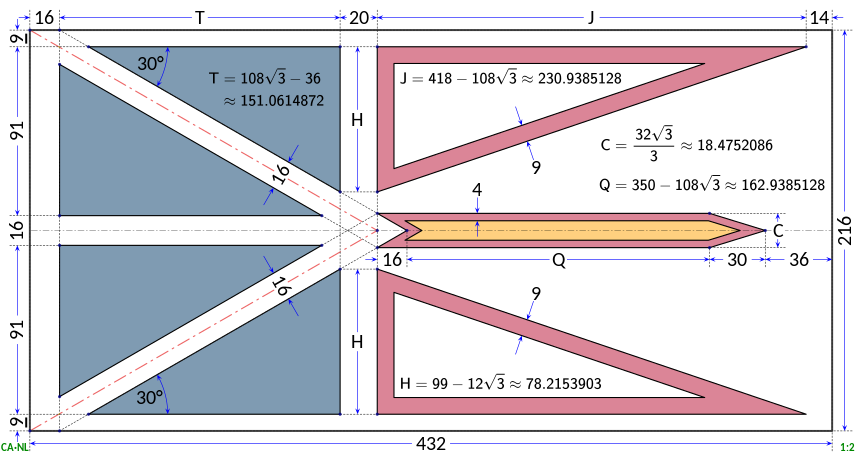
The Union Jack, or Union Flag, is the de facto national flag of the United Kingdom. The Union Flag was also used as the official flag of several British colonies and dominions before they adopted their own national flags. The flag continues to have official status in Canada, by parliamentary resolution, where it is known as the Royal Union Flag.

The Red Ensign or "Red Duster" is the civil ensign of the United Kingdom of Great Britain and Northern Ireland. It is one of the British ensigns, and it is used either plain or defaced with either a badge or a charge, mostly in the right half.

In British maritime law and custom, an ensign is the identifying flag flown to designate a British ship, either military or civilian. Such flags display the United Kingdom Union Flag in the canton, with either a red, white or blue field, dependent on whether the vessel is civilian, naval, or in a special category. These are known as the red, white, and blue ensigns respectively.

The flag of Bulgaria is a tricolour consisting of three equal-sized horizontal bands of white, green, and red. The flag was first adopted after the 1877–1878 Russo-Turkish War, when Bulgaria gained de facto independence. The national flag at times was charged with the state emblem, especially during the communist era. The current flag was re-established with the 1991 Constitution of Bulgaria and was confirmed in a 1998 law.

Nunatsiavut is an autonomous area claimed by the Inuit in Newfoundland and Labrador, Canada. The settlement area includes territory in Labrador extending to the Quebec border. In 2002, the Labrador Inuit Association submitted a proposal for limited autonomy to the government of Newfoundland and Labrador. The constitution was ratified on December 1, 2005, at which time the Labrador Inuit Association ceased to exist, and the new Government of Nunatsiavut was established, initially being responsible for health, education and cultural affairs. It is also responsible for setting and conducting elections, the first of which was executed in October 2006. An election for the ordinary members of the Nunatsiavut Assembly was held on May 4, 2010. Its incumbent president is Johannes Lampe who assumed office in 2016.

Regional tartans of Canada are represented by all Canada's provinces and territories having a regional tartan, as do many other regional divisions in Canada. Tartans were first brought to Canada by Scottish settlers; the first province to adopt one officially was Nova Scotia in 1956, and the most recent province was Ontario, in 2000. Except for the tartan of Quebec, all of the provincial and territorial tartans are officially recognized and registered in the books of the Court of the Lord Lyon, King of Arms of Scotland.

Nain is the northernmost permanent settlement in the Canadian province of Newfoundland and Labrador, within the Nunatsiavut region, located about 370 km (230 mi) by air from Happy Valley-Goose Bay. The town was established as a Moravian mission in 1771 by Jens Haven and other missionaries. As of 2021, the population is 1,204 mostly Inuit and mixed Inuit-European. Nain is the administrative capital of the autonomous region of Nunatsiavut.

Hopedale is a town located in the north of Labrador, the mainland portion of the Canadian province of Newfoundland and Labrador. Hopedale is the legislative capital of the Inuit Land Claims Area Nunatsiavut, and where the Nunatsiavut Assembly meets. As of the 2021 census, it has a population of 596.
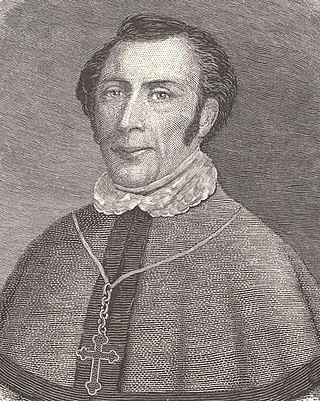
Michael Anthony Fleming, O.S.F. was an Irish-born Friar Minor who served as the Roman Catholic Church bishop of the Diocese of St. John's, Newfoundland. He was principally responsible for changing a small mission with several priests in four parishes into a large diocese with over 40,000 congregants and was the single most influential Irish immigrant to come to the Colony of Newfoundland in the 19th century. He was the principal creator of the Roman Catholic Cathedral of St. John the Baptist in St. John's.

Torngat Mountains National Park is a Canadian national park located on the Labrador Peninsula in the province of Newfoundland and Labrador. The park encompasses 9,700 km2 of mountainous terrain between Northern Quebec and the Labrador Sea. It is the largest national park in Atlantic Canada and the southernmost national park in the Arctic Cordillera. It partially contains the Torngat Mountains, the highest mountains in mainland Canada east of the Rocky Mountains.
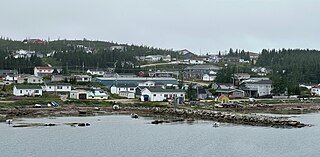
Makkovik is a town in Labrador in eastern Canada. It had 365 residents in 2021. The main industry is snow crabbing and there is a fishing cooperative.
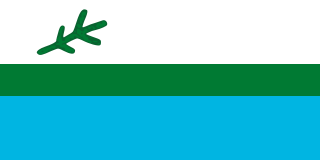
The flag of Labrador, while unofficial, is used to represent Labrador, the continental region with adjacent islands of the Canadian province of Newfoundland and Labrador as distinct from the Newfoundland region of the province. It was created by a small group led by Michael S. Martin, who was then the representative for Labrador South in the provincial legislature. The flag has been influential in Labrador; its colours are mirrored in the flag of Nunatsiavut, and its black (bog) spruce twig was adopted for use on the Franco-Terreneuvien flag. The black spruce, a member of the pine family, is the most numerous tree in Labrador and in the Province of Newfoundland and Labrador. The black spruce is the official tree of the Province of Newfoundland and Labrador and thus serves as a reminder that Labrador is part of that larger entity.

The Newfoundland Tricolour, or the Pink, White and Green, is an unofficial flag seen in the Canadian province of Newfoundland and Labrador, and is mistakenly believed to have been an official Flag of Newfoundland and Labrador, or more commonly, of the island of Newfoundland specifically.
The Newfoundland Natives' Society refers to a long-defunct patriotic organization in Newfoundland established in 1840 to protect the rights and privileges of Newfoundland-born and other longtime residents in dealings with colonial civil servants, big business owners who were not always residents, and newcomers who considered themselves much higher in the social structure than the locals even though the vast majority of locals were of the same British Isles ancestry as the new arrivals. The society's official mandate was to advance the careers and interests of native-born and other long-time residents. Newfoundlanders, regardless of gender, ethnic origin, religious affiliation or social standing were welcomed as members. This marked the arrival of a new phenomenon, Newfoundland nationalism. Natives' Society branches existed in St. John's, Harbour Grace and Carbonear as well, it is thought, in other communities.

Franco-Newfoundlanders, also known as Franco-Terreneuvians in English or Franco-Terreneuviens in French, are francophone and/or French Canadian residents of the Canadian province of Newfoundland and Labrador. The name Franco-Terreneuvian derives from Terre-Neuve, the French name of Newfoundland.

Newfoundland is a large island situated off the eastern coast of the North American mainland and the western part of the Canadian province of Newfoundland and Labrador, referred to as Labrador.
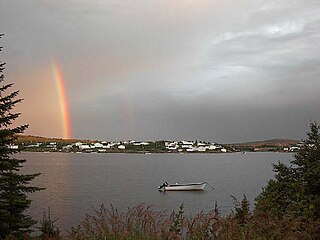
NunatuKavut is an Inuit territory in Labrador. It is unrecognized by other Indigenous groups in Canada, including the Innu Nation, the Nunatsiavut government, and the Inuit Tapiriit Kanatami. The NunatuKavut people claim to be the direct descendants of the Inuit that lived south of the Churchill or Grand River prior to European contact, with recent European admixture primarily from English settlers. Despite claims of Inuit heritage, according to recent censuses completed by Statistics Canada, the vast majority of individuals living in communities that NunatuKavut claims are within its region continue to identify as Métis as opposed to 'Inuit'.

The national flag of Ireland, frequently referred to in Ireland as 'the tricolour' and elsewhere as the Irish tricolour is a vertical tricolour of green, white and orange. The proportions of the flag are 1:2.

The Nunatsiavut Assembly Building in Hopedale, Newfoundland and Labrador is the seat of the autonomous Nunatsiavut Assembly.

The Nunatsiavut Assembly is the legislative branch of the government of Nunatsiavut, Canada.


